
aznsailorboi
-
Posts
298 -
Joined
-
Last visited
Content Type
Profiles
Forums
Store
Help Articles
Posts posted by aznsailorboi
-
-
not sure how a good dough should feel like? how does an "organical feel" feel like?
i knew i'd get into trouble with that "organical feel"

well, it's like, you know, it should kind of have the feel of a big relaxed muscle, yet sort of tacky... but actually, i think you'll know what i mean when you're there

When you first start kneading the dough, it will be quite tacky and rather wet in appearance. As you continue kneading, the consistency will change from tacky to firm, and it'll become visually smoother. Resist the temptation to stop kneading when you get to this stage because you're not finished yet. Keep kneading through the extremely firm, smooth stage; the dough will soon ease up a bit on firmness and become slightly tacky to the touch once again. That's when you're done.
ok I think I've been on this part before at one point or 2 ( since I did try baking bread twice
 ) I've been kneading say 10 min + then my dough gets to that firm consistency and becomes visually smooth.....but if i knead more the dough becomes less elastic, should that happen? coz it seems like if I knead more I might eventually end up with vulcanized rubber.... I mean if that happens I won't have to pay a fortune to change tires.....i'll just whip up some dough...
) I've been kneading say 10 min + then my dough gets to that firm consistency and becomes visually smooth.....but if i knead more the dough becomes less elastic, should that happen? coz it seems like if I knead more I might eventually end up with vulcanized rubber.... I mean if that happens I won't have to pay a fortune to change tires.....i'll just whip up some dough... 
-
Thanks again for the many replies! i've been enlightened quite a bit. I'm gonna try acquiring all these materials before the weekend, and hopefully be able to try a recipe as well.
I haven't got a chance to go find a different brand of yeast but I found this specialty baking store and I'm hoping they have a lot to offer...but if not I will definitely swing by whole foods.
ok another question to the experts and anybody who has 2 cents about it......what is that famed "sponge"??? what difference do you get from THE sponge vs. regular yeast slurry thats been activated for a few minutes?
-
Hello guys! I guess I belong to the weird people group as well hehe.....and I don't care...I've paid more than US$400 for a set of knives, which I use all the time and not as a display only. I've traveled a couple of miles more than I should've for a restaurant/bar/hole-in-the-wall mom and pop place. I know big culinary words. I could say I've eaten weird sh*t most people haven't...and could actually go for Fear Factor LOL. I ask for freshly cracked black pepper from a pepper mill in restaurants even though they have the salt and pepper shakers on the table. I can be cheap as hell for all other stuff but I never go cheap on food........*okay, and clothes...
 . I know what all the functions of each silverware on a formal dining setting. I've purposely dissed some friends on a movie premier for a restaurant opening...I know im bad on that one...but oh well life goes on. I can distinguish different types of soy sauce. I have more condiments in my pantry than my mom....although she competes in the number of pots, pans and skillet that I have. I'm a very impatient person, but I can slave a whole day in front of a stove and not complain at all. All this I've done for the glory of food.
. I know what all the functions of each silverware on a formal dining setting. I've purposely dissed some friends on a movie premier for a restaurant opening...I know im bad on that one...but oh well life goes on. I can distinguish different types of soy sauce. I have more condiments in my pantry than my mom....although she competes in the number of pots, pans and skillet that I have. I'm a very impatient person, but I can slave a whole day in front of a stove and not complain at all. All this I've done for the glory of food. 
-
- Does everyone have access to KA brand flour? or do I have to go to a specialty baking supply store to purchase it? (in chicago here)
I'm in the northern suburbs not too far from Lake Bluff and don't have any problems finding it. You might have to look in places other than Jewel/Dominicks though. Whole Foods carries it and I think Sunset Foods too.
But I wouldn't get overly hung up on the flour for basic bread. Pillsbury and Gold Medal bread flour should be OK too.
gotcha, i'll try sunset foods down on 43 later this afternoon. Thnks for the advice rickster
-
Honestly I've never had Yu Sheng/ Yu Sang before......
 I havnt seen it served by any of my aunts or my grandma whenever they host for CNY. hmm maybe i'll add that to my menu. anyone care to share their recipe?
I havnt seen it served by any of my aunts or my grandma whenever they host for CNY. hmm maybe i'll add that to my menu. anyone care to share their recipe? -
Ok I'm out of ideas for tonight's dinner and I don't care if my roomate likes it or not, I'm gonna make Bah Kut Teh and add the lotus root slices in and some dried lilly flower buds, hmm I think that would taste pretty good. add an interesting play of texture to the oh so yummy melt in your mouth pork...........

-
[...]The idea behind cooking jook in the new pots is to seal the micro cracks to prevent further damage that makes the cracks larger.
I saw some documentary programs on Discovery that they discovered that workers used rice portridge (congee) as an agent to glue the stones together in building The Great Wall. When dried and harden, congee is really strong.
Ah Leung!!!Ben and I just finished explaining to miladyinsanity that Cantonese congee is not glue!



oh hahahah that was funny....my coworkers probably think I'm nuts....I laugh all the time by myself while reading some of the funny comments on here...speaking of which, this is what I do all day, read eGullet......thank G*d for this site otherwise I'd be bored the hell ova here

well this technique seems to work well, coz i did try out my first pot when I got it and it was leaking quite a bit all over, and i even lifted it up on a trivet just to make sure it was coming from the pot and not just condensation. and now 5 clay pots later....they're all sealed now, but im still kinda wary about preheating it with full blast high on top of the stove...so i do it gradually, eventually it gets to that favorable hot pot temperature as well. I love using claypots in most dishes I make stove top, and very energy efficient. once you turn the stove on high and then let the pot boil, turn it down to the lowest setting and it will still keep it boiling on slow simmer, and another wonderful thing i noticed is the liquids dont evaporate as fast, so you can leave stews slow cooking the whole day.....imagine that!!!

-
Thanks for your replies guys, I really appreciate it. I've gathered alot of similarities with the tips and guidelines everyone is providing, and most of them I really havnt paid attention to.
ie.
- using less water than indicated on the recipe.
- my kneading technique....probably need to look for more kneading demo vid clips.
- not sure how a good dough should feel like? how does an "organical feel" feel like?
- I'm not sure of other brands of yeast in the local groceries (I meant was I haven't seen other brands).
- Does everyone have access to KA brand flour? or do I have to go to a specialty baking supply store to purchase it? (in chicago here)
- I'm confused with "Proofing"... some people put alot of emphasis on proofing yet some don't. But from what I'm seeing, I think it's a very important phase in baking, yet I really dont know what else is involved aside from the bread rising process, production of CO2 and gluten is formed.
Some of these pointers you guys mentioned I really do pay attention to like:
- Does my bread rise? yes it does.
- Correct oven temperature.
- Temp. of the water when slurrying the yeast.
Is the baking stone really a necessary equipment? or can I do without? if I do need it, where do i purchase it?
-
its coming up pretty soon guy!!!!
-
I started off with a bread machine, which are nearly foolproof and make a damn fine loaf. After I wore that out I got a KitchenAid HD mixer and have never looked back.
I used, (and still use), the King Arthur Flour 200th Anniversary Cookbook and the company's catalog as my instruction books, along with their products.
SB (one of the smartest things I ever did!)

thanks for the suggestion SB. Can a bread machine produce all types of bread or do you always have to buy the mix when baking bread.
From the previous threads, it seems like there's a big difference in the type of flour you use... I guess APF isn't really that versatile when baking breads. What type should I get?
-
Hi guys, I've always wanted to bake my own breads... ok so maybe this isn't my first time baking bread, but since I've only done it twice, and both times I failed, I guess I can still consider myself a first timer in this area of the kitchen.
Can you guys suggest ideas on what to start with, something like a no-brainer type recipe for a simple bread. Tips, do's and don'ts, and the like. I just want to boost my morale a little bit in baking. I've been trying to look for threads that focuses on just bread making but I havnt found any that covers the whole shebang on the subject.
I would also like to ask, what makes a bread dull looking, hard, and pale no matter how long you bake it? I swear I was trying to make bread not stone
 .....well at least thats what the recipe suggested I was making
.....well at least thats what the recipe suggested I was making 
-
Not to nitpick aznsailorboi, but Tagalog is indeed a language and not a dialect.
In other parts of the Philippines:
Mountain Province = tsu-om, du-om or do-om
Ilocos = dumdumen
Pangasinan = deremen
Tagalog and Visayan regions = pinipig
Indonesia = emping
By the way, I've uploaded a video of how the rice is pounded. The first part is for the detail, one mortar to three people. The second part is when at least three mortars assembled in one place have the pounding synchronised.
Click for the video.
It depends on how you look at it. Tagalog is a language but it is also a dialect. Tagalog is the dialect spoken in some of the regions in the lower Central Luzon to the upper Southern Luzon area, namely Bulacan, Rizal, Manila, Laguna, Batangas, Quezon, etc. Granted, most of the dialects branched out from Tagalog, it is both considered well as a Language and also a dialect.
just to clarify my point, refer to this analogy. Mandarin is China's national Language, its mostly spoken in the areas surrounding Beijing in the Northeast region. Cantonese, on the otherhand is also a widely spoken language but in the south in the areas of Hong Kong and Guangzhou. Both these languages are spoken widely but they are still called dialects, because they belong to the same country but divided by differences in the way of oral communication, though there are similarities, they are still distinctly different from each other.
-
I bought 3 pound of lotus roots yesterday, just for the heck of it since it was US$1.49 /lb. I dunno what to do with it now.... was thinking something like a stew with lotus roots, but all the recipes I found were soups and stir fries, and the occasional dessert. I stir fried some last night, and I have the powdery, starchy kind. Any suggestions?!?
-
When I bought my sandpot and a herb pot, the lady at the store told me to soak it overnight first, then air dry till the unglazed part doesnt have that water saturated look (ie. the wet areas look darker than the dry area) then she said to cook plain jook in it and cook it till the rice is almost dissolved and really thick almost like a paste, and when the jook is ready just pour out the contents to another pot, or another clay pot that you are prepping if you have more than one, and cook it for about the same amount of time with the other pot....transfer the jook to another pot or discard( you dont have to eat it.... so just use about half a cup rice ). then leave the pots unwashed for 24 hrs. then rinse well, then you can now use your clay pot, sandy pot, herb pot, etc. The idea behind cooking jook in the new pots is to seal the micro cracks to prevent further damage that makes the cracks larger. I just followed instructions....eheheh at least this time I asked before I left the store....(in reference to my dried sea cucumber experience
 )
) -
Some good-looking soups here!
aznsailorboi, this is a little nitpicky, but by "coconut sugar," do you mean normal palm sugar, or is it really from coconut palms?
I think they're just regular palm sugar.....hehe I just copied off the label on the packaging. but they do taste just like the regular palm sugar, i just didnt know what they're generically called in english.
-
oops i forgot the seasonings......
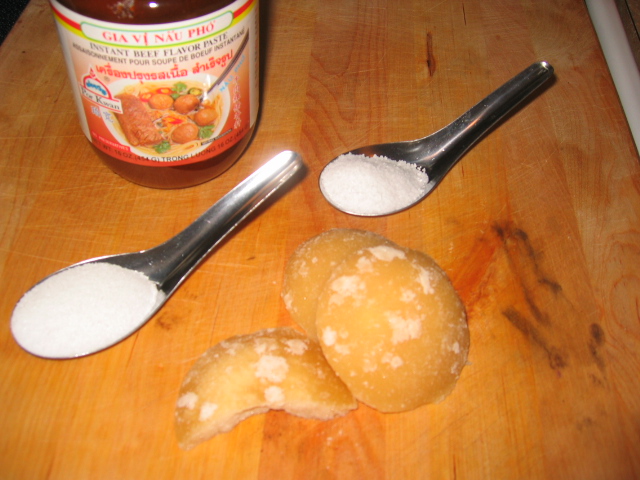
clockwise from top: Beef concentrate(optional) this just intesifies the beef flavor about 3 TBSP., MSG....yeah yeah i know its not good for you but i put it in anyways...about half a tablespoon, SALT about half a handful or less, depends on your taste, and coconut sugar, about 2 round disks...they're about 2 inches in across (not exactly but kinda gauge it from how big my spoons are lol....), I started seasoning after 12 hrs of boiling which would be pic # 9.
Then of course you also add more seasonings to it after its been ladled. The usual Hoisin Sauce, Sriracha chili sauce, chili garlic oil, fried garlic, more chilies (can't you guys tell I like my Pho fiery....it's called "Liquid A** Fire" in the morning lol )
**You guys probably wonder why there is no mention of FISHSAUCE. I add some in my bowl if the salt isn't enough, but I do not add it to the stock itself, coz I kinda notice that the fishy smell lingers in the broth... makes me think that the fishsauce smell doesnt meld to well with the beef broth.**
-

clockwise from top: onions, cinnamon stick, cloves and star anise
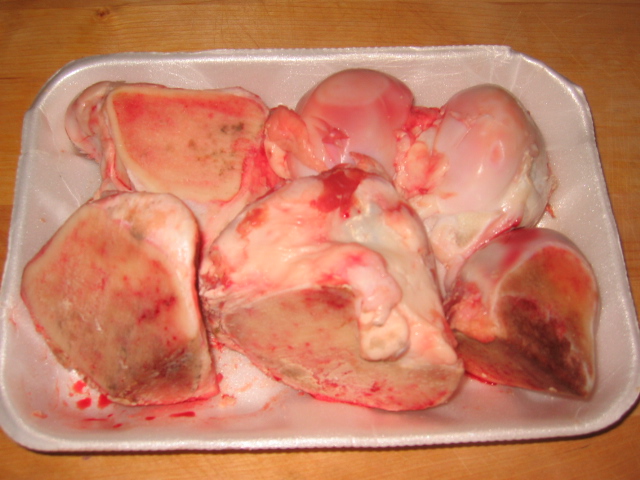
I rinsed these soupbones first in hot water a couple of times, then with just enough water to cover the bones in the pot bring it to a boil for about 15-20 minutes just enough to get most of the scum and blood to come out and coagulate.
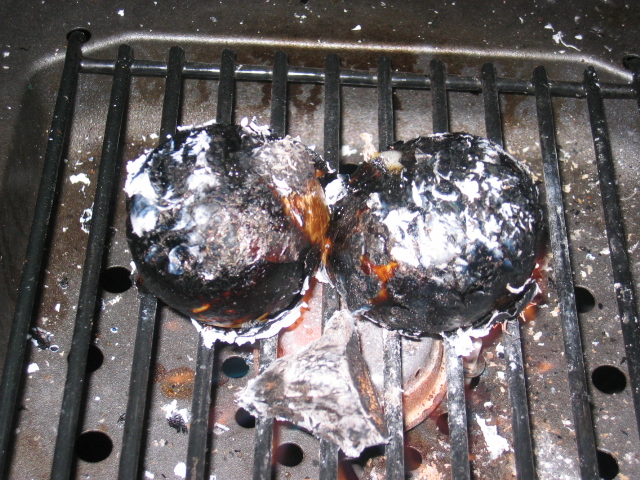
While waiting for the soupbones to boil. I charred the onions and the ginger till the outside skin is burnt and the inside is soft. Don't worry about the char outside the skin, you will have to rinse this in cold water to remove the excess burnt stuff.
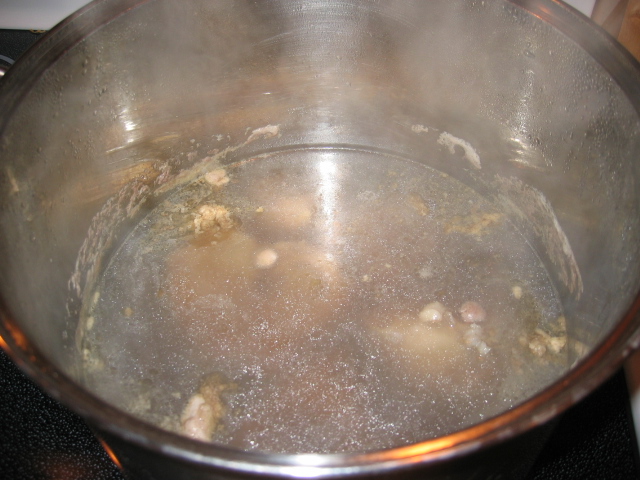
Meanwhile...this is after 20 minutes of boiling, got most of the scum floating by now.
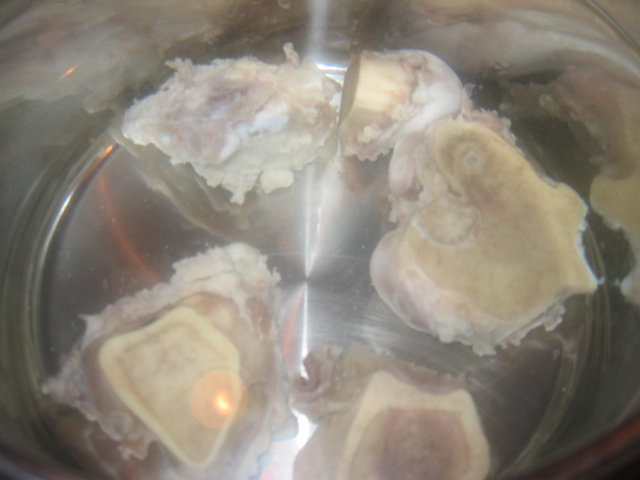
This is the soupbones that have been parboiled and rinsed in hot water until all the scum are gone. Then now with a stockpot full of water, begin to bring the bones to a boil again.
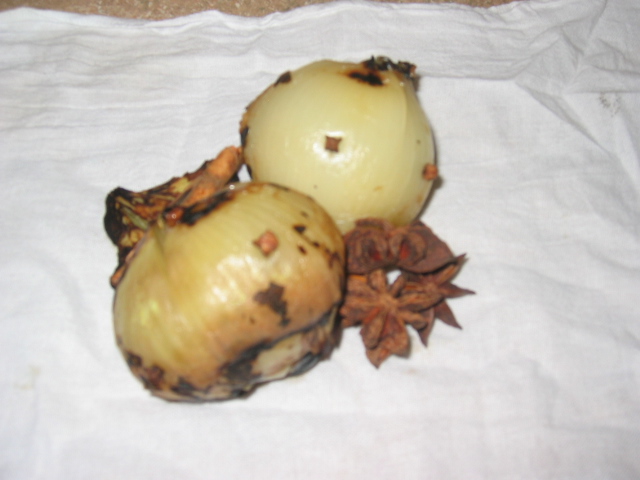
These are the aromatics, onions and ginger have been rinsed in cold water and most of the burnt skin removed, got the cloves stuck on the onions as well and the ginger smashed. add the cinnamon and star anise in the cloth and tie it up.
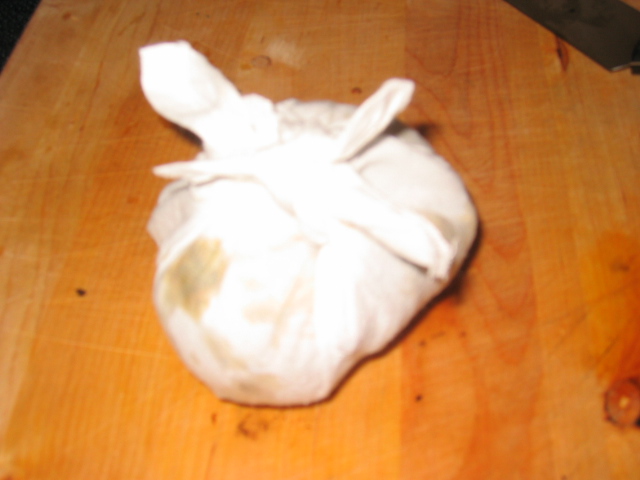
all tied up and ready to put in the pot.

....been boiling for about 2 hrs.. and I'm constantly skimming the thick grease on top as well, but not all, I leave just enough grease for flavor.
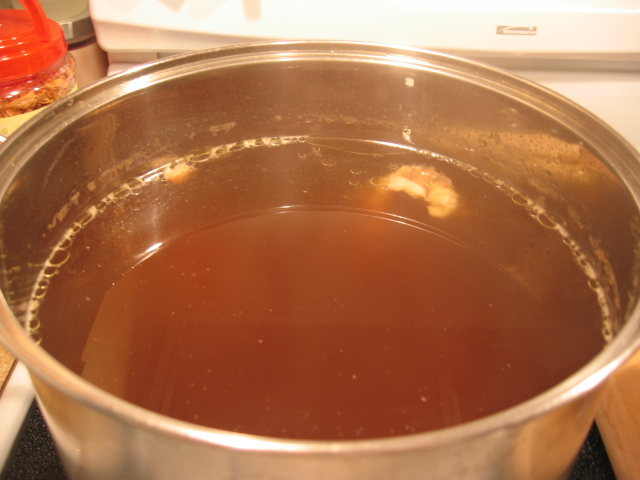
...this ones been boiling for 12 hrs now....nice deep color, but no seasonings yet.
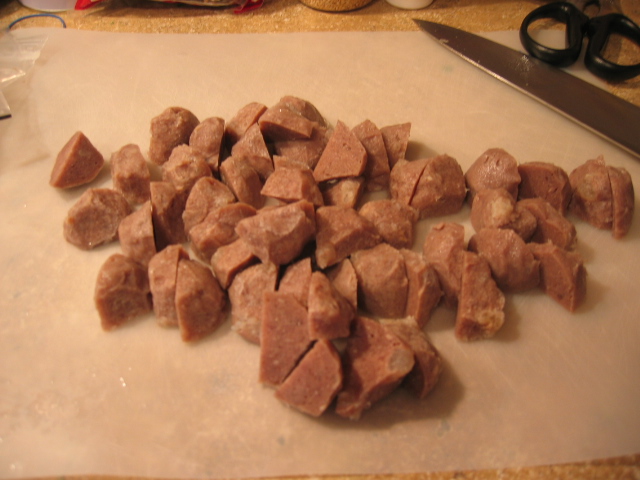
Beefballs with tendons.
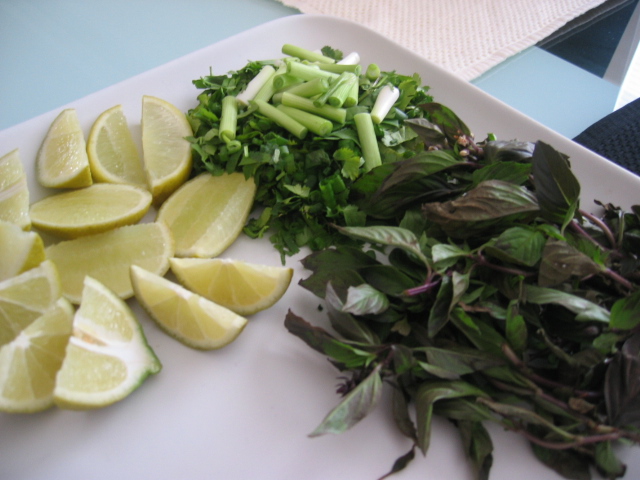
Limes, Cilantro and scallions chopped, I leave some of the white part cut pretty big, and basil.
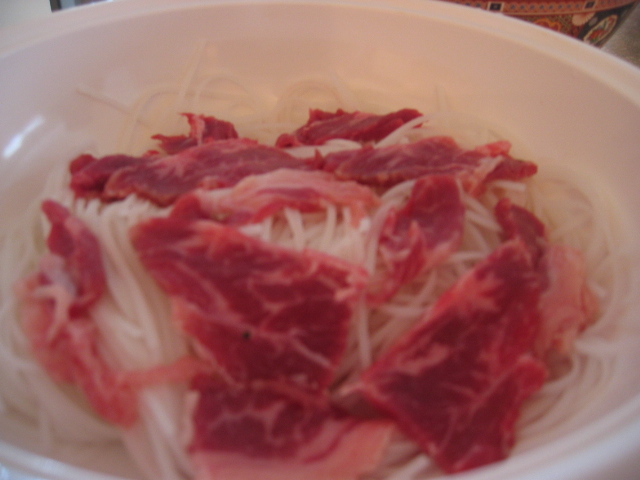
and the noodles and slices of beef.

and the finished creation by yourse truly
 .........end scene.
.........end scene.oh and btw this is my first posting of photos.... so i hope i did well.
-
I'm making my Pho now for tomorrow, but I won't be able to put up the pics yet coz its still not done, but I will be able to tomorrow night.
the purpose of the blackened aromatics imparts that nice brownish tinge to the soup as well. The onion and the ginger has that stronger scent to it when its fresh, and it usually lingers in the broth if placed in the soup fresh, on the other hand when its been charred they give a nice caramelized flavor and the caramel color.
-
Ooooh I was gonna make Pho too....but ellencho beat me to it.
 just kidding
just kidding  I will still make it this weekend and I will include my step by step photo thingy hehe I'll try to make it look as good as hz8rt's photos.
I will still make it this weekend and I will include my step by step photo thingy hehe I'll try to make it look as good as hz8rt's photos.I only use soup bones without meat on mine, coz it produces a clear broth than the ones made with bones with meat on it. but all the other ingredients are the same...charred onion and ginger, cinnamon, star anise, and cloves, and boiled for hours.

-
It's called "PINIPIG" in the Tagalog language, a dialect from the Philippines. there's only two uses for this that I know, one is like PPPans mentioned, and another one is by frying it in hot oil to puff it up just like rice crispies almost then sprinkled with granulated white sugar and eaten as is, or as delectable garnish on top of different rice cakes or the famous halo-halo.
-
-
I"M INNNNNN!!!!!!!!!!!!!!

-
doesn't sound too sacriligeous. The best tieguanyin starts off strong and unbalanced, with a perfect second cup, and then gradually becomes very subtle.. eventually very sweet. And a good tieguanyin is not bitter at all. OK, maybe occasionally a hint of bitterness, but not much more than any green tea. mmm now i will go have some.
we usually never get to the second cup, as my mom steals the pot off to the living room while she watches her chinese opera on betamax.... aiya!
 and one cup combined with sugar from the mooncake or other sweets is enough to keep us kids up and running about for hours.
and one cup combined with sugar from the mooncake or other sweets is enough to keep us kids up and running about for hours. -
I made congee (jook) and ma po tofu tonight following Ah Leung's recipes(a big thank you ), they were delicious, this is the closest I got to taste like the one in restaurants, didn't have the slower cooker, so use the stove top method for the congee, have anyone ever made congee in a pressure cooker before ? wondering how it would work.
when i was younger....not that im that old...only 21 here. our cook sometimes used the pressure cooker to cook congee specially when she's pressed for time, although i dont like the texture of it when its cooked that way, the rice does get soft quick and will also tenderize any meat you cook it with, but its always soupy, but it gets better the day after when the starch finally seeps out of the cooked rice and thickens it or after adding leftover cooked rice from lunch and boiling it for about an hour.
But whenever our cook is in her better moods she makes the most awesome congee ever, with pork stomach, beef tripe, and chicken or duck gizzards. boiled for a few hours over the stove cooked on a thick bottomed pot. nice, rich, thick and creamy and she would add some leftover rice about 20 min before serving it, so you will have some rice with some bite to it as well, nice play of textures. and we eat it with the side dishes on separate plates, century eggs, yau tieu, pork silk, pickled chili cucumbers, fermented bean curds, chili lo bok, chinese style fruit flavored beef jerky, cilantro, green onions, etc. oh and a raw duck, chicken or three quail eggs at the bottom of the bowl, then ladle the boiling congee in and then you stir it so the yolk mixes with the congee giving it a yellowish tinge. and the white coagulates into smooth curdles.....sigh.... memories.

Asian Noodle Soups--Cook-Off 18
in Cooking
Posted
I don't cook my noodles separate though, but I buy the fresh pho noodles and then soak in hot water from the faucet, then when I'm ready to serve I just layer them in the bowl, noodles at the bottom, then the raw beef slices then veggies. I make sure when I ladle my broth in, that the broth is boiling vigorously, this method tends to cook the noodles just enough but still leave it with that chewiness of the rice noodles....mushy isn't nice to eat.